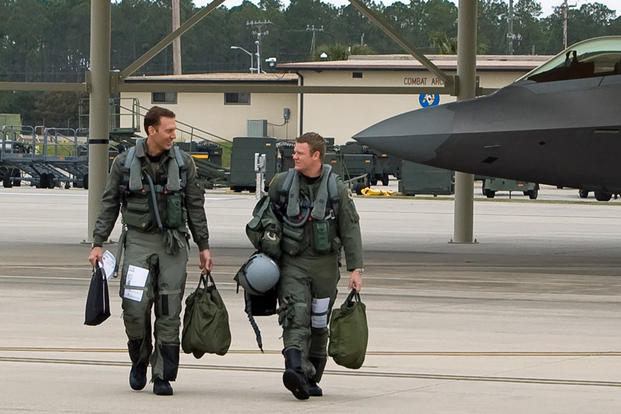The Air Force is planning to buy breathing sensors that will detect hypoxia-like symptoms in pilots before they can cause a crisis in flight.
The British company Cobham announced Tuesday that it had been notified it would receive an Air Force contract to develop the Aircrew Mounted Physiologic Sensing System 2.6, which according to the company is a breathing sensor suite that will predict the symptoms before they occur.
In 2011, the Air Force grounded its fleet of cutting-edge F-22 Raptors to investigate a rash of hypoxia-like incidents causing blackouts and other symptoms. It opted to equip the 5th-generation aircraft with backup oxygen systems in 2014.
According to the Cobham release, the new sensor suite will collect and store data, so if pilot breathing problems do occur, officials can rapidly identify a root cause. Inhalation and exhalation monitors mounted on the pilot's mask can ascertain that enough oxygen is being delivered to the pilot in flight. While Cobham is developing the inhalation module through internal funding, the company said, the Air Force is funding the exhalation module's development, as well as a pre-production hardware run for eight of the systems.
“This contract is another example of how Cobham continues to work closely with the US Air Force to determine root cause of the perplexing hypoxia like symptoms that continue to go unresolved,” Stuart Buckley, Cobham's senior director for business development and sales, said in a statement. “These breathing sensors are built upon our licensed gas sensing technology and will capture the data needed to help identify and ultimately prevent these symptoms from occurring.”
Cobham makes on-board oxygen generation systems for a wide range of U.S. aircraft.
Air Force officials have also spoken about the anticipated benefits of the aircrew-mounted sensor suite. In March, Air Force Surgeon General Lt. Gen. Mark Ediger told the House Appropriations Committee the service's research into the sensors was a component of a larger effort aimed at monitoring overall wellness of fighter pilots on the job.
"Our intent is to improve aeromedical psychology procedures for early identification and outreach of airmen flying with untreated distress and negative changes in their psychological (emotional, behavioral, and social) functioning," he said.
Navy and Marine Corps pilots have also reported troubling episodes of cockpit hypoxia in F/A-18 Hornets and EA-18G Growler Aircraft. In August, Vice Adm. Mike Shoemaker, the commander of Naval Air Forces, told an audience at the Center for Strategic and International Studies that the problem was the 'number one safety issue' for naval aviation.
Cobham executives previously told Military.com that they had participated in briefings with Navy officials focused on the on-board sensor systems, but it's not clear if the service will invest in the technology.









